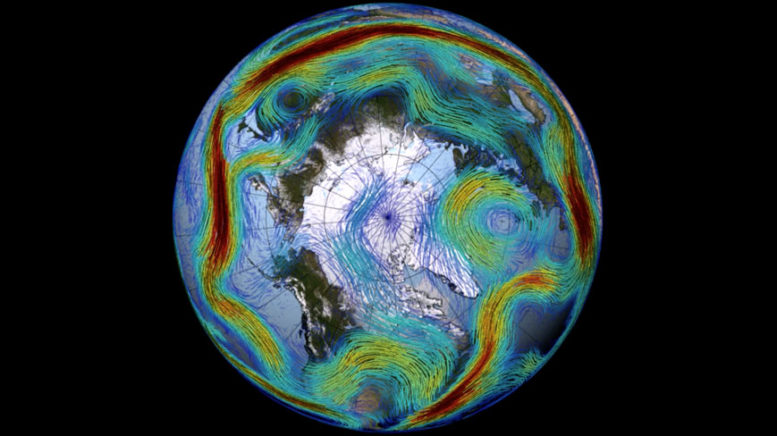Rossby waves naturally occur in rotating fluids. Within the Earth’s ocean and atmosphere, these waves form as a result of the rotation of the planet. These Rossby waves play a significant role in shaping weather and climate. An animation from NASA’s Goddard Space Flight Center shows both long and short atmospheric waves as indicated by the jet stream. The colors represent the speed of the wind ranging from slowest (light blue colors) to fastest (dark red). There are Oceanic waves and Atmospheric Rossby waves, which are also known as Planetary waves.
Oceanic Rossby Waves. Ocean waves come in different shapes and sizes. Slow-moving oceanic Rossby waves are fundamentally different from ocean surface waves. Unlike waves that break along the shore, these Oceanic Rossby waves are huge, undulating movements of the ocean that stretch horizontally across the planet for hundreds of kilometers in a westward direction. They are so large and massive that they can change Earth’s climate conditions. Along with rising sea levels, King Tides, and effects of El Niño, the Oceanic Rossby waves add to high tides and coastal flooding in some regions.
The Rossby wave movement is complex. The horizontal wave speed (the amount of time it takes the wave to travel across an ocean basin) of a Rossby wave is dependent upon the latitude of the wave. In the Pacific, for instance, waves at lower latitudes (closer to the equator) may take months to a year to cross the ocean. Waves that form farther away from the equator (at mid-latitudes) of the Pacific may take closer to 10 to 20 years to make the journey.
The vertical motion of Rossby waves is small along the ocean’s surface and large along the deeper thermocline —the transition area between the ocean’s warm upper layer and colder depths. This variation in vertical motion of the water’s surface can be quite dramatic: the typical vertical movement of the water’s surface is generally four inches or less, while the vertical movement of the thermocline for the same wave is about 1,000 times greater.
For a four-inch or less surface displacement along the ocean surface, there may be more than 300 feet of corresponding vertical movement in the thermocline far below the surface! Due to the small vertical movement along the ocean surface, oceanic Rossby waves are undetectable by the human eye. Scientists rely on satellite radar altimetry to detect the massive waves.
Atmospheric Rossby Waves. According to the National Weather Service, atmospheric Rossby waves form primarily as a result of the Earth’s geography. These Atmospheric Rossby waves help transfer heat from the tropics toward the poles and cold air toward the tropics in an attempt to return the atmosphere to a balance. They also help locate the jet stream and mark out the track of surface low pressure systems. The slow motion of these waves often results in fairly long and persistent weather patterns.
